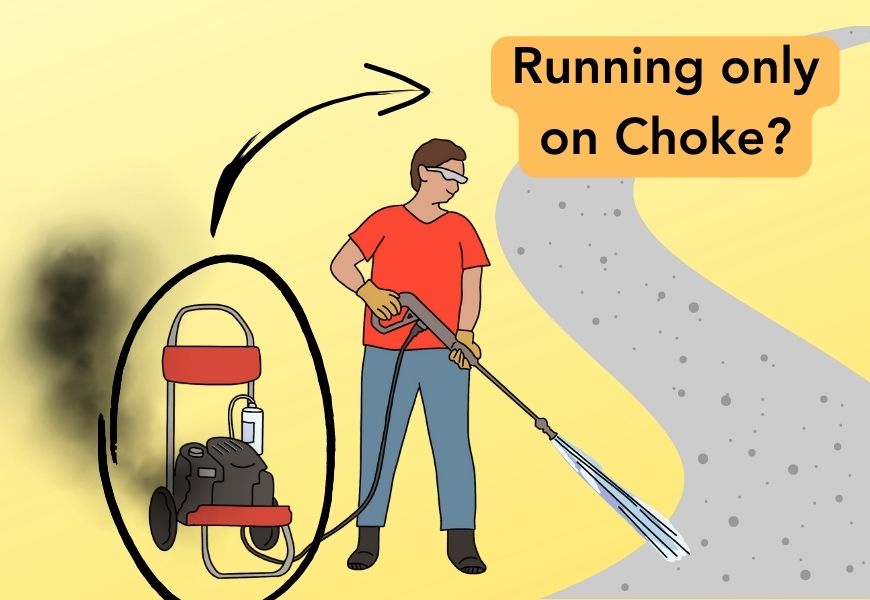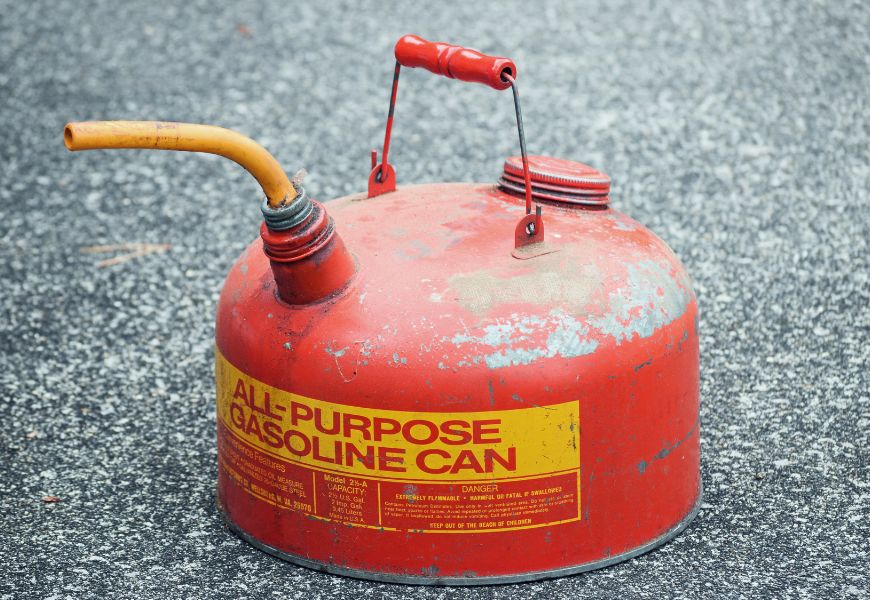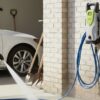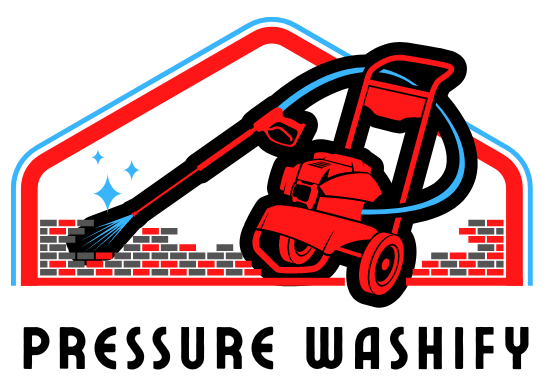Affiliate Disclaimer: This post may contain affiliate links, meaning we get a commission if you decide to make a purchase through our links, at no extra cost to you.

A pressure washer is an essential tool for cleaning various surfaces, from driveways and sidewalks to decks and vehicles. However, it can be frustrating when your pressure washer only runs on choke, affecting its performance and efficiency.
This issue, if left unaddressed, can lead to damage to the pressure washer and reduce its lifespan.
What is Choke?
A choke is a key component found in the engines of many machines, including pressure washers. Its main function is to control the air-fuel mixture that goes into the engine for combustion.
When you start a cold engine, the choke closes and limits the airflow, creating a richer fuel mixture. This richer mixture helps the engine start more easily.
As the engine warms up, you open the choke, allowing more air to mix with the fuel.
What Does It Mean When a Pressure Washer Only Runs on Choke?
It indicates that the engine is not getting the right fuel-air mixture when the choke is released. This can lead to poor performance, stalling, and even engine damage if not resolved promptly.
Common Reasons for Pressure Washers Only Running on Choke
There could be several reasons for your pressure washer running only on choke. Understanding these causes can help you diagnose and fix the issue more effectively. Here are the most common reasons:
Air Leak
An appropriate air-fuel mixture is crucial for efficiently operating your pressure washer’s engine. An air leak can disrupt the mixture in the system. This can cause the engine to only run when the choke is engaged.
Air leaks can occur in various parts of the engine, such as the carburetor, intake manifold, or gaskets.
Dirty Fuel System
A dirty fuel system can restrict the flow of fuel to the engine, causing it to run only on choke. Dirt, debris, and varnish can build up in a fuel tank, fuel lines, and carburetor.
A clogged carburetor can reduce fuel flow. Over time, these problems worsen.
Wrong Type of Gas
Using the wrong fuel in your pressure washer can also cause it to run only on a choke. Pressure washers typically require gasoline with a specific octane rating.
Using fuel with a lower rating can cause engine problems and other issues.
Blocked Air Filter
Another possible reason is a dirty or clogged air filter. The air filter plays a crucial role in ensuring that the engine receives clean air for proper combustion.
Over time, the air filter can become saturated with dirt, dust, and debris, restricting the airflow to the engine. The engine may have difficulty keeping the ideal air-fuel mixture when the choke is opened. This can result in it running only with the choke engaged.
Troubleshooting Steps for Pressure Washer Running Only on Choke

To diagnose and fix the issue causing your pressure washer to run only on choke, follow these troubleshooting steps:
Check the Choke Lever Position
Before diving into more complex solutions, ensure that the choke lever is in the correct position. Locate the choke lever on your pressure washer’s engine. Verify that it is fully open when the engine is warmed up.
If the lever is stuck or not moving smoothly, clean and lubricate it to ensure proper operation.
Inspect for Air Leaks
Check for air leaks in the pressure washer’s engine system, focusing on the carburetor, intake manifold, and gaskets. You can do this by spraying a carburetor cleaner or soapy water around these areas while the engine is running.
If you notice a change in the engine’s idle speed or see bubbles forming, it indicates an air leak.
To fix an air leak in a pressure washer engine:
- Find the leak: Look for damaged gaskets, loose connections, or cracks.
- Check carburetor: Tighten bolts, screws, and replace damaged parts.
- Inspect intake manifold: Look for cracks or damage, and ensure proper connections.
- Examine engine head gasket: Replace if damaged or worn.
- Check crankcase: Ensure a proper seal and replace damaged parts.
- Test pressure washer: Start the washer and check for remaining leaks. Consult a professional if needed.
Clean the Fuel System
Cleaning the fuel system can help resolve issues caused by dirt and debris restricting fuel flow. To clean the fuel system of a pressure washer, follow these steps:
- Drain the old fuel: Remove any old or contaminated fuel from the pressure washer’s fuel tank.
- Clean the fuel tank: Use a fuel tank cleaner or a mixture of water and mild detergent to clean the inside of the tank. Rinse thoroughly and let it dry completely before refilling.
- Replace the fuel filter: Remove and replace the fuel filter to ensure clean fuel flows through the system.
- Clean the carburetor: Remove the carburetor and clean it using a carburetor cleaner. Pay attention to the jets, float bowl, and other components. Reassemble and reinstall the carburetor.
- Inspect fuel lines: Check the fuel lines for any cracks or damage. Replace any damaged lines to prevent leaks and ensure proper fuel flow.
- Use a fuel additive: Add a fuel system cleaner to the fresh gasoline before refilling the tank. This can help remove any remaining deposits or buildup in the fuel system.
- Run the pressure washer: Start the pressure washer and let it run for a few minutes to circulate the cleaner through the fuel system.
We recommend using the STA-BIL Carburetor cleaner for great results.
STA-BIL Carb/Choke & Parts Cleaner

- Quickly dissolves dirt and grime
- For all types of engines
- No oily residue
- Improves fuel consumption
Use the Correct Type of Gas
Verify that you are using the correct type of gas for your pressure washer by referring to the owner’s manual. If you have been using the wrong type of gas, drain the fuel tank and refill it with the recommended gasoline.
Additionally, avoid using gas that has been sitting for an extended period, as it can degrade and cause performance issues. Always use high-quality, fresh fuel for your pressure washer.
Also, Check out this easy-to-follow video:
What is the Correct Type of Gas for Your Pressure Washer?
Determining the correct type of gas for your pressure washer is crucial for optimal performance and longevity of the engine. To find the right type of gas, consult the owner’s manual that came with your pressure washer.
The manual will specify the recommended octane rating and any other requirements, such as ethanol content or the use of fuel stabilizers.
If you don’t have the manual, you can often find this information on the manufacturer’s website or by contacting their customer support.
As a general rule, ensure that the optimal octane number for gas to be used in a pressure washer is a minimum of 87 and ethanol should be up to 10%.

How to Check the Quality of Gas Before Using in a Pressure Washer?
Here are some tips to help you assess the quality of the gas:
- Visual inspection: Pour a small amount of gas into a clear container and check for any debris, dirt, or water. Clean gas should be free of contaminants and appear clear.
- Smell: Gas that has gone bad often has a sour or stale odor. If the gas smells off, it’s best not to use it in your pressure washer.
- Age: Gasoline can degrade over time, losing its combustibility and effectiveness. Avoid using gas that has been stored for more than 30 days without a fuel stabilizer.
- Color: Fresh gasoline typically has a light amber color. If the gas appears dark or discolored, it may be contaminated or degraded and should not be used.
Final Words
Letting your pressure washer run only on choke is a bad idea. It can damage your machine beyond repair.
However, a close inspection and some DIY maintenance can save you a lot of money and keep your pressure washer running for a long time.
Read more: Pressure Washer Maintenance Guide.







